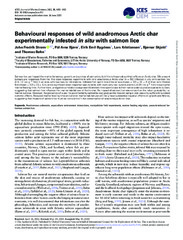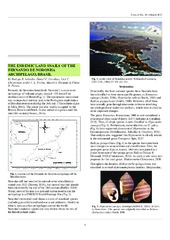Artikler, rapporter og annet (arktisk og marin biologi): Recent submissions
Now showing items 361-380 of 1643
-
Behavioural responses of wild anadromous Arctic char experimentally infested in situ with salmon lice
(Journal article; Tidsskriftartikkel; Peer reviewed, 2022-06-24)Salmon lice can impact the marine behaviour, growth, and survival of salmonids, but little is known about their effects on Arctic char. We present behavioural responses from the first dose-response experiment with wild anadromous Arctic char (n = 50) infested in situ with salmon lice (0.0–1.2 lice g<sup>−1</sup> fish) in an area with low natural infestations. Infested fish spent less time at sea ... -
Uptake of sympagic organic carbon by the Barents Sea benthos linked to sea ice seasonality
(Journal article; Tidsskriftartikkel; Peer reviewed, 2022-11-11)On Arctic shelves, where primary production occurs in both the pelagic and sympagic (ice-associated) habitats, sympagic organic material (OM) can constitute a disproportionate fraction of benthic diets due to higher sinking rates and lower grazing pressure than pelagic OM. Less documented is how sympagic OM assimilation across feeding guilds varies seasonally and in relation to sea ice duation. We ... -
Light and freshwater discharge drive the biogeochemistry and microbial ecology in a sub-Arctic fjord over the Polar night
(Journal article; Tidsskriftartikkel; Peer reviewed, 2022-09-30)The polar night has recently received increased attention as a surprisingly active biological season. Yet, polar night microbial ecology is a vastly understudied field. To identify the physical and biogeochemical parameters driving microbial activity over the dark season, we studied a sub-Arctic fjord system in northern Norway from autumn to early spring with detailed monthly sampling. We focused ... -
Predation research with electronic tagging
(Journal article; Tidsskriftartikkel; Peer reviewed, 2022-12-15)Predation is a fundamental aspect of ecology that drives ecosystem structure and function. A better understanding of predation can be facilitated by using electronic tags that log or transmit positions of predator or prey species in natural settings, however, there are special considerations that must be made to avoid biased estimates. We provide an overview of the tools available for studying ... -
Genome-Wide Identification and Expression Analysis of SnRK2 Gene Family in Dormant Vegetative Buds of Liriodendron chinense in Response to Abscisic Acid, Chilling, and Photoperiod
(Journal article; Tidsskriftartikkel; Peer reviewed, 2022-07-22)Protein kinases play an essential role in plants’ responses to environmental stress signals. SnRK2 (sucrose non-fermenting 1-related protein kinase 2) is a plant-specific protein kinase that plays a crucial role in abscisic acid and abiotic stress responses in some model plant species. In apple, corn, rice, pepper, grapevine, Arabidopsis thaliana, potato, and tomato, a genome-wide study of the ... -
The endemic land snails of the Fernando de Archipelago, Brasil
(Journal article; Tidsskriftartikkel, 2022)Fernando de Noronha (henceforth ‘Noronha’) is an oceanic archipelago of volcanic origin, located ~350 km off the northeast coast of Brasil (Fig. 1). The eponymous main island was an important midway port in the Portuguese exploitation of Brasilian resources during the 16th and 17th centuries (Lins & Silva, 2013). The island was also briefly occupied by the British, French and Dutch. It also ... -
Cicadas in Japanese video games and anime
(Journal article; Tidsskriftartikkel; Peer reviewed, 2022)If you ever watched an anime, chances are at some point you have heard an incessant buzzing sound in the background. Those are cicadas, the sound of summer in Japan. Summer only truly arrives when the cicadas start singing (Kendall, 2014).<p> <p>Whenever it is summer in an anime, TV series, movie, or game, you can be almost sure to hear cicadas on the background. Their sound is an easy and ... -
The sea slugs of Shiroi Suna no Aquatope
(Journal article; Tidsskriftartikkel; Peer reviewed, 2022)Shiroi Suna no Aquatope (白い砂のアクアトープ) is a new anime by P.A. Works that started airing in the summer season of 2021 (Fig. 1). In a broad sense (to avoid spoilers), the anime focuses on the daily life of the staff working in a small aquarium in Okinawa. Its official title in English is The Aquatope on White Sand and, from this point on, we’ll refer to it as Aquatope for simplicity. -
Geomechanical assessment of the Lower Turonian AR-F limestone Member, Abu Gharadig Field, Egypt: Implications for unconventional resource development
(Journal article; Tidsskriftartikkel; Peer reviewed, 2022-12-08)This study evaluates the unconventional reservoir geomechanical characteristics of the Lower Turonian Abu Roash-F (AR-F) carbonates from the Abu Gharadig field, onshore Egypt, which has not been attempted before. The interval dominantly consists of planktic foraminifera and micrite matrix. The AR-F marine carbonate is organic-rich (0.59–3.57 wt% total organic carbon), thermally mature (435–441°C ... -
Floods and flood management and its socio-economic impact on Pakistan: A review of the empirical literature
(Journal article; Tidsskriftartikkel; Peer reviewed, 2022-12-01)Flood is one of the most damaging natural disasters as the recent floods have shown their serious impact on Pakistan. Flood control and regulation policies are essential to reduce the risks of economic downturn, a threat to human existence, and to sustain the ecology. The severity of flood catastrophe activities represents a constant and severe issue in the world. Floods are rising year by year ... -
Spatiotemporal dynamics of forest geometrid outbreaks
(Journal article; Tidsskriftartikkel; Peer reviewed, 2022-11-24)We highlight recent developments and avenues for advancement, which can improve insight into the causes of changes in the spatiotemporal dynamics of forest Geometridea moth species (hereafter ‘geometrids’). Some forest geometrids possess fundamental biological traits, which make them particularly liable to outbreak range expansions and host shifts mitigated by climate change. Indeed, recently ... -
First trait-based characterization of Arctic ice meiofauna taxa
(Journal article; Tidsskriftartikkel; Peer reviewed, 2022-11-18)Trait-based approaches connect the traits of species to ecosystem functions to estimate the functional diversity of communities and how they may respond to environmental change. For the first time, we compiled a traits matrix across 11 traits for 28 species of Arctic ice meiofauna, including Copepoda (Subclass), Nematoda (Phylum), Acoela (Order), Rotifera (Phylum), and Cnidaria (Phylum). Over 50 years ... -
Characteristics of early Atlantic cod (Gadus morhua L.) catches based on otoliths recovered from archaeological excavations at medieval to early modern sites in northern Norway
(Journal article; Tidsskriftartikkel; Peer reviewed, 2022-11-17)We compared stock origin, size- and age-distributions, and length growth rates derived from Atlantic cod otoliths from archaeological excavations at two sites in northern Norway: Vágar in Lofoten (68◦12 N, ad 1156–1285) and the Værbukta site (70◦57 N, ad 1450–1680). For comparison, modern otoliths were sampled during 1993–2001 from areas situated close to Vágar and Værbukta. Length-at-age from ... -
Origin of marine invertebrate larvae on an Arctic inflow shelf
(Journal article; Tidsskriftartikkel; Peer reviewed, 2022-10-20)Many benthic invertebrate taxa possess planktonic early life stages which drift with water currents and contribute to dispersal of the species, sometimes reaching areas beyond the current ranges of the adults. Until recently, it had been difficult to identify planktonic larvae to species level due to lack of distinguishing features, preventing detection of expatriate species. Here, we used DNA ... -
Natural variation in snow depth and snow melt timing in the High Arctic have implications for soil and plant nutrient status and vegetation composition
(Journal article; Tidsskriftartikkel; Peer reviewed, 2022-02-16)Snow cover is a key component in Arctic ecosystems and will likely be affected by changes in winter precipitation. Increased snow depth and consequent later snowmelt leads to greater microbial mineralization in winter, improving soil and vegetation nutrient status. We studied areas with naturally differing snow depths and date of snowmelt in Adventdalen, Svalbard. Soil properties, plant leaf ... -
Challenges and opportunities when implementing strategic foresight: lessons learned when engaging stakeholders in climate-ecological research
(Journal article; Tidsskriftartikkel; Peer reviewed, 2022-01-13)Ecosystems are currently experiencing rapid changes. Decision-makers need to anticipate future changes or challenges that will emerge in order to implement both short-term actions and long-term strategies for reducing undesirable impacts. Strategic foresight has been proposed to help resolve these challenges for better planning and decision-making in an uncertain future. This structured process ... -
Temporal dynamics in zooplankton δ13C and δ15N isoscapes for the North Atlantic Ocean: Decadal cycles, seasonality, and implications for predator ecology
(Journal article; Tidsskriftartikkel; Peer reviewed, 2022-10-17)The limited amount of ecological data covering offshore parts of the ocean impedes our ability to understand and anticipate the impact of anthropogenic stressors on pelagic marine ecosystems. Isoscapes, i.e., spatial models of the distribution of stable isotope ratios, have been employed in the recent years to investigate spatio-temporal patterns in biogeochemical process and ecological responses. ... -
Ectoparasites population dynamics are affected by host body size but not host density or water temperature in a 32-year long time series
(Journal article; Tidsskriftartikkel; Peer reviewed, 2022-11-22)Host density, host body size and ambient temperature have all been positively associated with increases in parasite infection. However, the relative importance of these factors in shaping long-term parasite population dynamics in wild host populations is unknown due to the absence of long-term studies. Here, we examine long-term drivers of gill lice (Copepoda) infections in Arctic charr (Salmonidae) ... -
Joining the dots: systematics and biogeography of Punctoidea land snails
(Conference object; Konferansebidrag, 2022-11) -
Dynamical Controls of the Eastward Transport of Overwintering Calanus finmarchicus From the Lofoten Basin to the Continental Slope
(Journal article; Tidsskriftartikkel; Peer reviewed, 2022-09-06)Diapausing populations of Calanus finmarchicus at depth in the Lofoten Basin (LB) return to the continental shelf and slope off the Lofoten-Vesterålen Islands during the phytoplankton spring bloom to feed and spawn, forming surface swarms with a great abundance. To study how overwintering populations of C. finmarchicus move with the deep currents and return to the shelf, Lagrangian transport ...


 English
English norsk
norsk


















